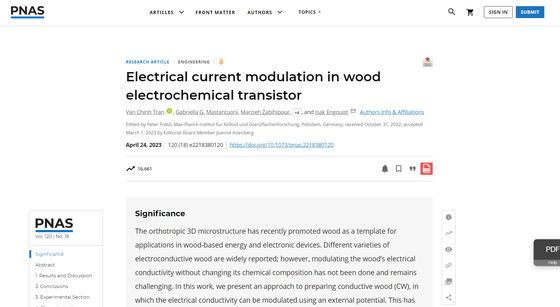The world's first 'wooden transistor' is developed

Researchers at the University of Linkoping in Sweden and the Royal Institute of Technology (KTH) in Sweden have announced that they have succeeded in creating transistors that can operate continuously by combining wood for the first time in the world.
Electrical current modulation in wood electrochemical transistor | PNAS

The world's first wood transistor - Linköping University
https://liu.se/en/news-item/varldens-forsta-tratransistor
A transistor is an electronic component that controls and amplifies current, and by combining transistors you can build a logic circuit and create a computer that performs various calculations. Transistors are usually made of ``semiconductors'' such as silicon crystals and germanium, which have intermediate properties between ``conductors'' that conduct electricity and ``insulators'' that do not conduct electricity.
Researchers at Linköping University and KTH have announced that they have developed a transistor by combining three pieces of balsa wood like a cross. The balsa wood is stripped of lignin , a biopolymer, and is further impregnated with a conductive polymer called PEDOT:PSS (polyethylenedioxythiophene and polystyrenesulfonic acid dispersion). By combining long cellulose fibers and conductive polymers, we have succeeded in obtaining a maximum conductivity of 69 S/m even though it is made of wood.

Below are the components of the wooden transistor.

It seems that attempts to make transistors using wood have been made so far, but it is said that only ion transport can be adjusted, and it has stopped functioning when ions are gone. However, the wooden transistor developed in this research can continuously control the flow of electricity without deterioration.
In my experiments with this wooden transistor to turn it on and off, it took 1 second to turn it off and 5 seconds to turn it on, but it worked continuously at a certain output level. It seems that I found out.
In modern times, transistors have become as small as nanometers, and they are so high-performance that they can be switched on and off billions of times per second. So, of course, this wooden transistor is not immediately applicable to the semiconductor industry, nor is it revolutionary.
Isak Enquist, senior associate professor at the University of Linköping, said, 'We didn't make wooden transistors with a specific use in mind. We made them because we could. This is basic research, and it's possible. It shows that there is something, and I hope that it will trigger further research that will lead to future applications.'

Related Posts:






